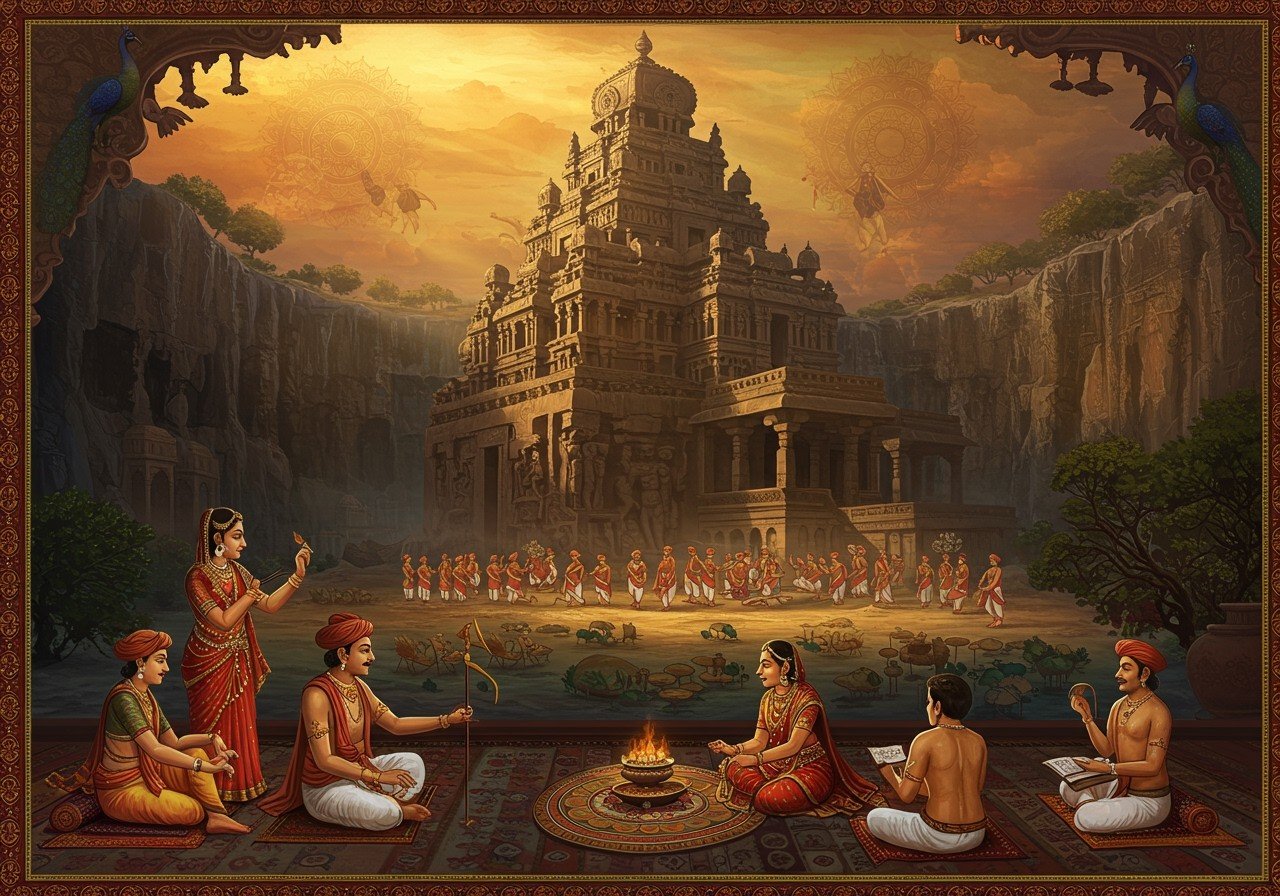
The Rashtrakuta Empire, a prominent dynasty ruling large parts of the Indian subcontinent between the 6th and 10th centuries, left an indelible mark on India’s cultural landscape. Known for their military strength, administrative efficiency, and patronage of the arts, they fostered a rich blend of religious tolerance, cultural diversity, and societal advancements. This blog post delves into the religious practices, cultural richness, and societal structure of the Rashtrakuta Dynasty, providing insights into their lasting impact on Indian history.
Religious Practices of the Rashtrakutas
The Rashtrakutas exhibited remarkable religious tolerance, patronizing various faiths, including Shaivism, Vaishnavism, and Jainism. This inclusive approach fostered a diverse spiritual environment where different religious communities thrived. The construction of magnificent temples, such as the iconic rock-cut Kailasa temple at Ellora dedicated to Lord Shiva, showcases their architectural prowess and religious fervor. Jainism flourished under their rule, evidenced by the construction of prominent Jain temples and the support extended to Jain scholars. Buddhism also received royal patronage, with the Rashtrakutas sponsoring Buddhist monasteries.
Furthermore, the Rashtrakutas encouraged religious debates and philosophical discussions in their courts. These intellectual exchanges played a crucial role in shaping regional culture and society, fostering an environment of learning and critical thinking.
Language and Literature under the Rashtrakutas
Sanskrit, the language of classical Indian tradition, served as the court language of the Rashtrakutas. However, they also championed regional languages like Kannada and Marathi, leading to a flourishing of literature and inscriptions in these languages. This bilingual approach reflects their commitment to both classical tradition and regional cultural expression.
The Rashtrakutas were great patrons of literature, supporting poets and scholars in their courts. Kannada poet Pampa, renowned for his epic “Adipurana” narrating the life of the first Jain Tirthankara, and Sanskrit poet Trivikrama, author of “Nalachampu,” are notable examples of literary figures who flourished under Rashtrakuta patronage. The themes explored in these literary works often blended religious, philosophical, and courtly subjects, reflecting and shaping the cultural ethos of Rashtrakuta society.
Cultural Practices and Societal Structure
Rashtrakuta society observed a variety of rituals, festivals, and daily life activities. Major festivals like Mahashivaratri held significant importance, with specific rituals and celebrations associated with them. Temple architecture and iconography played crucial roles in religious and cultural life, reflecting the dynasty’s artistic sensibilities and spiritual beliefs.
Rashtrakuta society followed a hierarchical structure, with a well-defined caste system. The king occupied the highest position, followed by nobles, warriors, merchants, and farmers. This social order maintained stability and facilitated efficient governance. Women held significant roles in Rashtrakuta society, participating in religious and cultural activities, and some even holding administrative positions.
Agriculture formed the backbone of the Rashtrakuta economy, with farmers cultivating crops like rice, wheat, and sugarcane. Trade flourished, with merchants engaging in both domestic and international commerce, exchanging goods like textiles, spices, and precious stones. The Rashtrakutas implemented a robust and decentralized system of governance, granting local rulers autonomy while maintaining central control. This administrative approach contributed to the empire’s stability and prosperity. Taxation was systematic, with land revenue serving as a primary source of income. The Rashtrakutas also extended their patronage to artisans and craftsmen, encouraging the production of fine goods and further stimulating economic growth.
Poojn.in: Connecting to Rashtrakuta Heritage
The Rashtrakuta Dynasty’s reverence for spiritual practices is reflected in the use of sacred objects like Rudraksha beads. Poojn.in, India’s leading cultural goods and services store, offers a wide selection of authentic Rudraksha beads, connecting modern devotees to these ancient traditions. Just as during the Rashtrakuta era, Rudraksha beads, meaning “Rudra’s (Shiva’s) eyes,” continue to hold deep spiritual significance across various Indian languages and traditions.
- Sanskrit: रुद्राक्ष (Rudraksha) – Explore our collection of Rudraksha malas crafted with the same reverence as those used during the Rashtrakuta period.
- Malayalam: രുദ്രാക്ഷം (Rudraksham) – Discover certified Nepali Rudraksha beads, ensuring authenticity and quality, just as the Rashtrakutas valued.
- Punjabi: ਰੁਦਰਾਕਸ਼ (Rudraksha) – Find Rudraksha combinations for specific purposes, continuing the tradition of using these beads for various spiritual intentions.
- Odia: ରୁଦ୍ରାକ୍ଷ (Rudraksha) – Adorn yourself with authentic silver and gold Rudraksha pendants, reflecting the artistic patronage of the Rashtrakutas.
Visit Poojn.in today to explore our complete range of Rudraksha products and other ritual items, allowing you to connect with the rich spiritual heritage of the Rashtrakuta Dynasty.
Conclusion
The Rashtrakuta Dynasty’s contributions to Indian history are vast and enduring. Their military prowess, administrative efficiency, and cultural patronage shaped a significant period in the subcontinent’s development. Their legacy continues to inspire and inform, reminding us of the rich tapestry of traditions they nurtured. From their magnificent temples to their support of literature and the arts, the Rashtrakutas left an indelible mark on India’s cultural landscape.
Explore more about Indian culture and heritage with our related blog posts:
- Andhra Pradesh Coastal Temples: A Sacred Journey
- Draksharama Temple Visit: Your Complete Guide
- Sirpur: A Journey Through History, Culture, and Monuments


